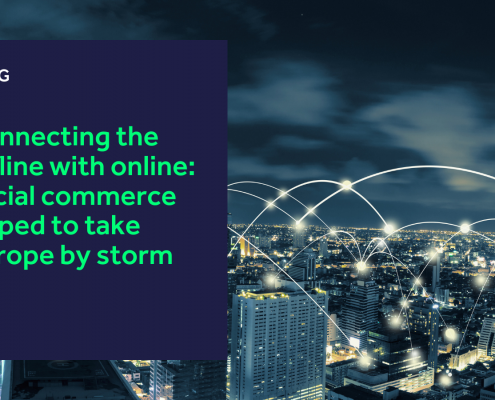While many retailers in western countries are struggling to adapt in the wake of the pandemic, China and other Asian markets have been pioneering the industry’s next digital revolution.
Social commerce has exploded in popularity in the last 18 months, driven by consumers increasingly seeking online experiences in the midst of local lockdowns.
Retailers in the APAC region have tapped into this and begun to bridge the gap between the physical and digital worlds whilst simultaneously bolstering their number of sales.
Indeed, our own research revealed 39% of retail leaders believe at-home experiences driven by online channels will be the defining CX model of the next decade. Further, 61% plan to continue bridging the gap between offline and online which itself suggests social commerce will soon be commonplace.
Social commerce – the next big trend?
Live streaming is one the biggest examples of shoppertainment. It involves retailers (usually alongside an influencer) hosting a video in real-time to connect with their consumers and showcase their latest products.
The trend began as early as 2016 and three years later, Chinese livestream revenues amounted to a staggering $63 billion. By June 2020, it was estimated retail commerce sales in China would reach $242 billion by the end of the year.
Last March, Burberry China hosted a livestream that attracted 1.4 million viewers and this ultimately led to many of its featured product selling out within an hour.
Social commerce has gathered so much traction in recent years that the remainder of the world is quickly clamoring to jump on the bandwagon.
For example, Shopify has been exploring Artificial Intelligence (AI) technology to support digital ‘try-on’ experiences that help show consumers what products would look like on them.
Remarkably, it found conversion rates had been shown to increase by 250% for products that supported 3D models in Augmented Reality (AR).
Elsewhere, Ralph Lauren and Snap Inc. partnered together to create branded apparel for virtual avatars – showcasing yet another innovative digital solution to boost revenue streams in the fashion industry.
“With Ralph Lauren’s respected reputation as a global leader within the luxury fashion space and Snap’s undeniable creative prowess and expansive reach to a younger consumer, we feel inspired to explore disruptive ways to tell our brand’s story, drive social commerce and engage a new generation in an authentic and empowering way,” said Alice Delahunt, Ralph Lauren’s Chief Digital Officer.
Social commerce is a new path forward for all retailers
The ingenious concept of social commerce works so effectively because of its limited nature.
Influencers with millions of followers present numerous offers that must be claimed almost immediately, leading people to make purchases out of the fear of missing out.
Viya Huang – who boasts an immeasurable following – managed to attract 20 million people in a single evening. Throughout the stream, she presented a box of spicy duck necks (a Wuhan specialty) and said they would be prepared fresh and shipped to customers.
Huang managed to flog 70,000 boxes of the product within seconds to raise money for a Wuhan recovery charity initiative.
The trend undoubtedly benefits larger retailers who can strike deals with huge influencers. However, social commerce also presents a new path forward for small, up and coming businesses.
Dou Ma began streaming in March 2020 and attracted less than 20 viewers per night. Within months, she was subsequently able to grow her channel and draw in more than 100 people per stream.
Live streaming afforded her the opportunity to sell goods without having to go through the hassle of opening up a store – particularly in the midst of COVID.
“Because of this pandemic, livestreaming has become a good option,” said Dou.
“It’s no longer practical for newcomers like me to open an offline store anymore.”
Europe is ready to embrace shoppertainment
Research commissioned by AliExpress has shown that ‘shoppertainment’ may still be nascent in Europe (especially in comparison to Asia) but shoppers are “open to embrace new trends and technologies that can enhance their shopping experience”.
The survey – which comprised of 14,460 respondents in France, Poland, Spain and the UK – illustrated how 70% of people have expressed interest in social commerce specifically.
Further, almost half of them said they increased their consumption of shoppertainment content during the pandemic.
“There is real commercial opportunity for sellers and retailers who know how to leverage this trend strategically,” said Vita Chang, AliExpress’ head of content operations ecosystem.
“When exploring the European opportunity, it is important to look into distinctions for each country to cater the right messages for different consumers in different countries.”
This is an important point to note as UK shoppers desired entertaining content that was fit for mobile screens while those in France indicated they prefer content endorsed by influencers.
AliExpress itself is leveraging information about this growing trend in a bid to expand into Europe. It has already hosted more than 44,000 live shows in 13 different languages since July 2019.
In fact, the company’s eCommerce platform, Alibaba, is on the prowl for 100,000 influencers and content creators all across the world with the view of attracting one million of them by 2023.
Likewise, Shopify – a platform used by 820,000 businesses to sell goods – is also attempting to propel shoppertainment into the west.
It announced several news services, including live streaming, alongside a partnership with TikTok in a move to push and grow the trend overseas from the APAC region.
Given the efforts made by the likes of AliExpress and Shopify thus far, it seems clear that social commerce will soon be permeating retail markets all across Europe.
 https://www.k3btg.com/wp-content/uploads/2022/05/The-Courtauld-Blog.png
900
1600
Jordan Heal
https://www.k3btg.com/wp-content/uploads/2022/03/K3_Master_Colour_RGB.svg
Jordan Heal2022-05-11 14:14:082024-03-19 15:20:20The Courtauld transforms visitor experience with K3 Imagine
https://www.k3btg.com/wp-content/uploads/2022/05/The-Courtauld-Blog.png
900
1600
Jordan Heal
https://www.k3btg.com/wp-content/uploads/2022/03/K3_Master_Colour_RGB.svg
Jordan Heal2022-05-11 14:14:082024-03-19 15:20:20The Courtauld transforms visitor experience with K3 Imagine

